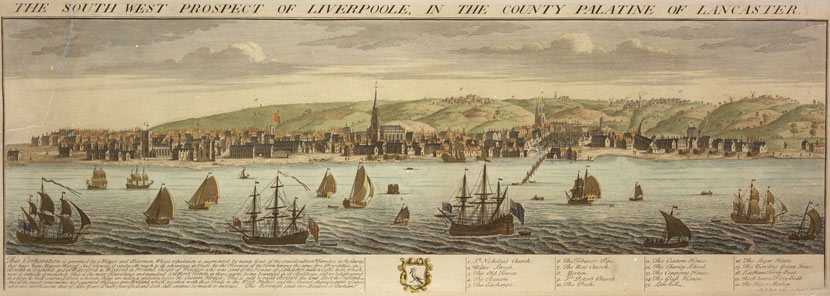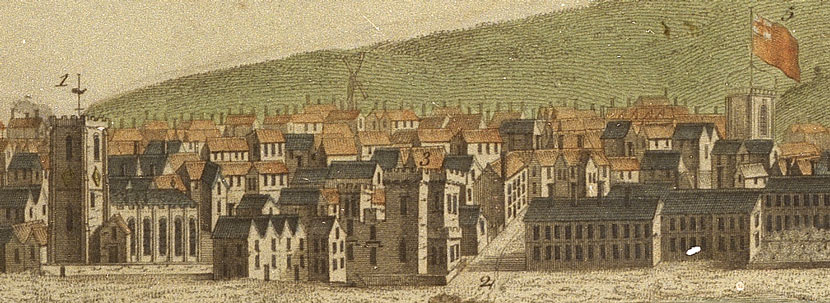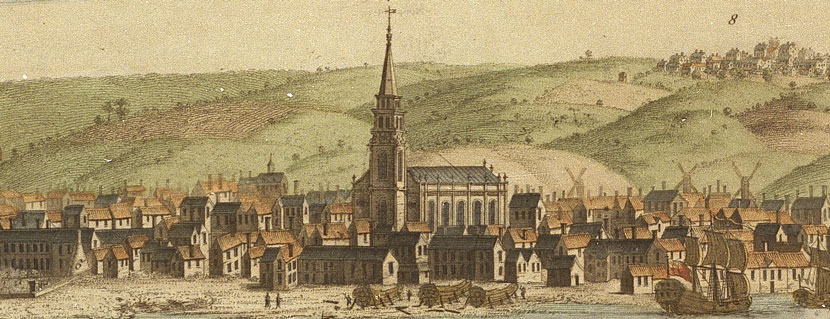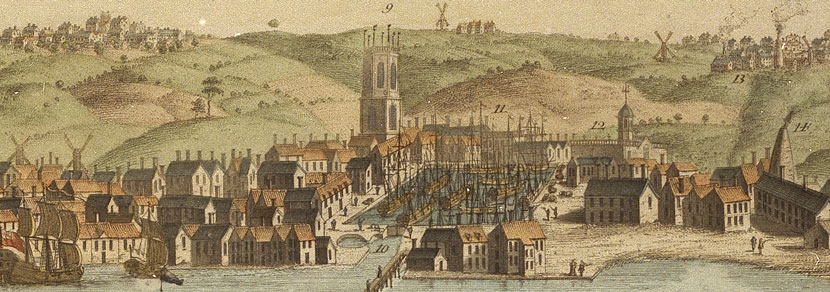A Prospect of Liverpool

Visitors to the Museum of Liverpool marvel at Ben Johnson's 'Liverpool Cityscape'. This is the latest fabulous piece of art in a long line of views of Liverpool which capture the developing town/city at different periods. The Buck view of Liverpool of 1728 shows Liverpool as its potential as a mercantile trading centre is budding.
 On this view we can see some fascinating buildings which have since been lost or altered:
On this view we can see some fascinating buildings which have since been lost or altered:
 Detail showing St Nick's on the left, the Tower in the centre and the Exchange Buildings on the right.
St Nick's church (numbered 1) or more formally, 'Our Lady and St Nicholas' is shown nearer the waterfront than it is today, demonstrating how much land was reclaimed from the river in the 19th century when docks were constructed along the waterfront. The building shown is a predecessor of the modern church, which was rebuilt following the tower collapsing in 1810 and Second World War damage.
The Tower (numbered 3) was given a licence to crenellate, adding defensive parapets, in 1406. It was a private town residence of the Stanleys, Earls of Derby, until it was forfeited in 1649 after the Civil War. It was later used as a prison, and as a temporary civic space before the completion of the Town Hall in 1754.
The Exchange Buildings (numbered 5) are shown with a flag flying atop the tower. Standing at the present Exchange Flags, these were effectively predecessors of the Town Hall, and were used for trade and as a prison.
Detail showing St Nick's on the left, the Tower in the centre and the Exchange Buildings on the right.
St Nick's church (numbered 1) or more formally, 'Our Lady and St Nicholas' is shown nearer the waterfront than it is today, demonstrating how much land was reclaimed from the river in the 19th century when docks were constructed along the waterfront. The building shown is a predecessor of the modern church, which was rebuilt following the tower collapsing in 1810 and Second World War damage.
The Tower (numbered 3) was given a licence to crenellate, adding defensive parapets, in 1406. It was a private town residence of the Stanleys, Earls of Derby, until it was forfeited in 1649 after the Civil War. It was later used as a prison, and as a temporary civic space before the completion of the Town Hall in 1754.
The Exchange Buildings (numbered 5) are shown with a flag flying atop the tower. Standing at the present Exchange Flags, these were effectively predecessors of the Town Hall, and were used for trade and as a prison.
 Detail showing St George's church
The very prominent church near the centre of the image is St George’s which stood at Derby Square after the demolition of the castle which stood here. The site was identified for a church when Liverpool was made an independent parish in 1699, and St George's was built 1726-1734. It was designed by Thomas Steers, who was also the engineer of the Old Dock. It closed in 1897 and was demolished in 1899.
Detail showing St George's church
The very prominent church near the centre of the image is St George’s which stood at Derby Square after the demolition of the castle which stood here. The site was identified for a church when Liverpool was made an independent parish in 1699, and St George's was built 1726-1734. It was designed by Thomas Steers, who was also the engineer of the Old Dock. It closed in 1897 and was demolished in 1899.
 Detail showing the Old Dock, St Peter's Church, a kiln on the right and windmills in the distance
Liverpool's ‘Old Dock’ was built 1709-1715. It was an innovative scheme to enable ships to moor and unload goods for a longer period than was previously possible in open water with changing tides. Part of this structure was excavated in advance of the development of the Liverpool One shopping centre, and is preserved in situ under the ground, and visitors can view it on a tour from the Merseyside Maritime Museum.
The church viewed behind the Old Dock (numbered 9) is St Peter’s Church, Church Street, Liverpool. Founded in 1715, this became the first pro-Cathedral for Liverpool after city status was granted in 1880. It was demolished in 1922 after work had started on the Anglican Cathedral.
A kiln near the waterfront (numbered 14) hints at some of the early industry in the town. This was probably for glassmaking - a glasshouse is marked on this area in the early and detailed map of Liverpool, drawn by Eyes in 1765.
There are numerous windmills on the hills behind Liverpool, and while those shown may be positioned with some artistic licence they do represent the large number of mills there would have been in Liverpool. In this period they were used for grinding wheat to make bread flour, later they were also utilised for production of materials linked to industry.
The developing cityscape is explored site-by-site in the Merseyside Archaeological Society publication, Changing Face of Liverpool available via the Museum of Liverpool shop.
Detail showing the Old Dock, St Peter's Church, a kiln on the right and windmills in the distance
Liverpool's ‘Old Dock’ was built 1709-1715. It was an innovative scheme to enable ships to moor and unload goods for a longer period than was previously possible in open water with changing tides. Part of this structure was excavated in advance of the development of the Liverpool One shopping centre, and is preserved in situ under the ground, and visitors can view it on a tour from the Merseyside Maritime Museum.
The church viewed behind the Old Dock (numbered 9) is St Peter’s Church, Church Street, Liverpool. Founded in 1715, this became the first pro-Cathedral for Liverpool after city status was granted in 1880. It was demolished in 1922 after work had started on the Anglican Cathedral.
A kiln near the waterfront (numbered 14) hints at some of the early industry in the town. This was probably for glassmaking - a glasshouse is marked on this area in the early and detailed map of Liverpool, drawn by Eyes in 1765.
There are numerous windmills on the hills behind Liverpool, and while those shown may be positioned with some artistic licence they do represent the large number of mills there would have been in Liverpool. In this period they were used for grinding wheat to make bread flour, later they were also utilised for production of materials linked to industry.
The developing cityscape is explored site-by-site in the Merseyside Archaeological Society publication, Changing Face of Liverpool available via the Museum of Liverpool shop.
